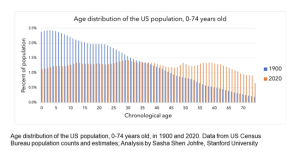summit
The New Map of Life

Human life expectancy nearly doubled in the US and many other high income countries in the 20th century. This is one of the most remarkable achievements in human history. This increase in the odds of surviving to old age, coupled with a decline in fertility, led to a profound shift in population distribution in the developed world. Rather than a population pyramid, the above graphic for the US shows that age is now fairly evenly distributed across the life span.
Comparable distribution of age in the population presents significant challenges to health and economic planning. It also presents opportunities. Today we are seeing great strides in not only living longer, but in living healthy active lives longer. Despite a prevailing focus on “aging” societies, we believe the bigger story is the wide range of new opportunities made possible by age diversity. Never before in human history have we had the opportunity to benefit from the strength, speed, and ambition of youth coupled with the experience, emotional evenhandedness, and prosocial tendencies represented in older people.
How will our most critical systems across the economic, societal, and cultural domains adjust? The Stanford Center on Longevity’s report on The New Map of Life, which was released in November 2021, challenges leaders across every sector to reimagine the potential of longer lives so that we can build structures to support them.
Cogenerating Social Change
The new map of life doesn’t just open up new possibilities for older adults. It significantly expands the potential for win-win solutions that benefit younger and older generations. Some of the possibilities of this moment were highlighted in a 2021 13-part series in the Stanford Social Innovation Review. As described in this series, we are already seeing important social innovations that shift away from a century of age segregation and reimagine social systems that take advantage of age diversity.
Healthy longevity adds new stages to life and opportunity to live with more flexibility and satisfaction. This longevity dividend can open the door for lifelong learning and purposeful contributions. Experienced older people working in concert with younger activists can help unlock progress around the biggest challenges of our time. Marc Freedman, CEO of Encore.org and author of How To Live Forever: The Enduring Power of Connecting the Generations, calls this rapidly spreading paradigm for turbo-charging social change “cogeneration.” One example of this is Bill McKibben’s recently launched new climate organization Third Act.
With multiple generations alive at the same time, we can dramatically expand resources to support children and families in the earliest years of their lives. See e.g., the work of AARP’s Educare and UCLA’S Generation Xchange. As our country invests more attention and dollars to support our youngest children through childcare and preschool, older generations can become part of the paid and volunteer workforce. Intergenerational connections can enrich communities and strengthen shared ambitions.
How Philanthropy Must Respond
These opportunities are just the tip of the iceberg. Philanthropists interested in greeting this moment can serve as catalysts for innovation to reimagine what is possible with the new healthy longevity.
The first step is for philanthropists to adapt strategies to reflect the new map of life. Many funders operate according to an older map of life. For example, traditional funding streams typically focus on narrative parts of the lifespan, with dollars tied to younger or older populations in isolation from one another. The second step is for philanthropists to use its flexibility and freedom to proactively advance new ideas, narratives, rules of the game, and innovation solutions that rework critical systems for the reality of age diversity.
Philanthropy has long played a role in normalizing new ways of thinking about who belongs and whose voices must be part of the solution. Some funders will play a role in telling a new story. Other funds may help scale solutions or advocate for new policies. Together, such efforts will call forth a future where the radical inclusion of younger and older people has become the new normal.
Imagine what could become possible if we increasingly rely on younger, older, and the oldest generations to be part of the social change equation?
